

深圳大学:增效型水凝胶电解质,实现能量自主和可穿戴传感
电子说
描述
【深圳大学:增效型水凝胶电解质,实现能量自主和可穿戴传感】
传统的热电转换技术以热电发生器为特征,利用基于固态半导体的电子塞贝克效应来实现热流到电流的直接转换。然而,这些热电发生器通常具有刚性、毒性或热功率低(约为 uV K-1)的缺点,这阻碍了它们在可穿戴电子设备中的进一步发展。相比之下,热电偶电池(TEC,又称热电化学电池或热电偶电池)可在室温下产生较大的热功率,因此特别适用于收集人体和可穿戴电子设备的低品位废热。在温度梯度下,一个电极发生氧化反应,另一个电极发生还原反应。这些连续的氧化还原反应导致电子在外电路中不断流动,并在冷热电极之间产生电位差,从而产生很大的热电化学塞贝克系数(Se),其数量级为mV K-1。
为了推动柔性和可穿戴应用的发展,近期有关 TEC 的研究越来越多地将重点转向水凝胶电解质。对于柔性设备来说,水凝胶电解质可以避免传统液基 TEC 的电解质泄漏和复杂封装问题。然而,柔性和可穿戴 TEC 的开发面临着一些挑战,其中最主要的是如何提高其热电化学性能。提高热功率以实现高效率对于最大限度地利用低品位热源进行能量转换至关重要。在提高热功率的同时,还面临着提高机械强度的挑战,特别是对于基于水凝胶的 TEC 而言,因为它们必须具备强大的机械性能,以承受撕裂、弯曲和扭曲。这一点在可穿戴应用中尤为重要,因为在这些应用中,灵活性和耐用性是不可或缺的,而目前的研究却在很大程度上忽视了这一点。除了热功率低和机械强度不足外,目前的准固态 TEC 还缺乏在受到严重外部损坏后恢复的能力,这大大限制了它们在柔性和可穿应用中的实用性。
研究成果
柔性准固态热电偶(TEC)的快速发展为可穿戴电子设备提供了一条崭新的发展道路。然而 机械强度和功率输出的不足仍然阻碍着它们的进一步应用 。 深圳大学陈光明教授团队 研究展示了一种“一石二鸟”策略,可协同增强基于[Fe(CN)6]3-/4-的热电偶的机械和热电化学特性。通过甜菜碱齐聚物引入多种非共价相互作用, 传统脆性明胶水凝胶电解质的机械强度从50 kPa 大幅提高到440 kPa,伸展性接近 250% 。同时,甜菜碱齐聚物强烈影响了[Fe(CN)6]3-的溶解结构从而扩大了熵差,并将热电化学塞贝克系数从1.47 mVK-1提高到2.2 mV K-1。由此产生的准固态 TEC 显示出0.48 mW m-2 K-2的超高归一化输出功率密度,与未进行齐聚离子调节的同类产品相比,整体性能有了显著提高。此外,固有的热可逆特性使TEC能够通过溶胶转化反复进行自我恢复,从而确保可靠的能量输出,甚至在发生极端机械损坏的情况下也能对 TEC 进行回收利用。作者还进一步设计了一种由18个独立TEC组成的能量自主智能手套,它可以同时监测任何被触摸物体不同位置的温度,在可穿戴应用中展现出巨大的潜力。
图文导读
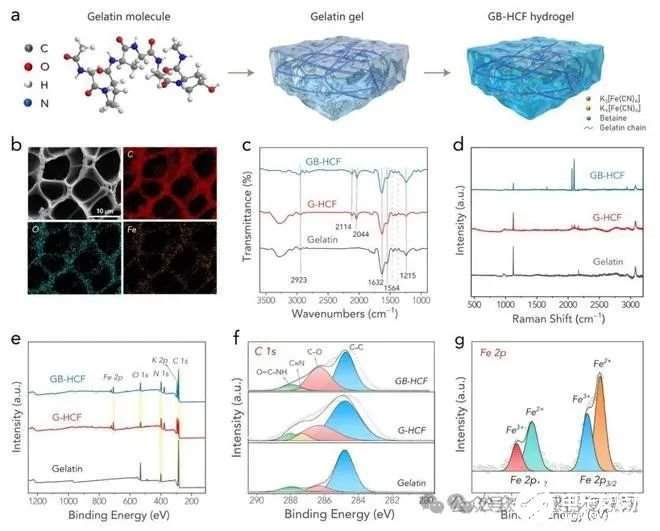
Figure 1. (a) An illustration of the forming process of the GB-HCF hydrogel. (b) An SEM image of the GB-HCF and the corresponding elemental mapping images. (c) FTIR spectra of various samples. (d) Raman spectra of various samples. (e) XPS full spectra of various samples. (f) XPS C1s spectra of various samples. (g) XPS Fe2p spectrum of the GB-HCF.
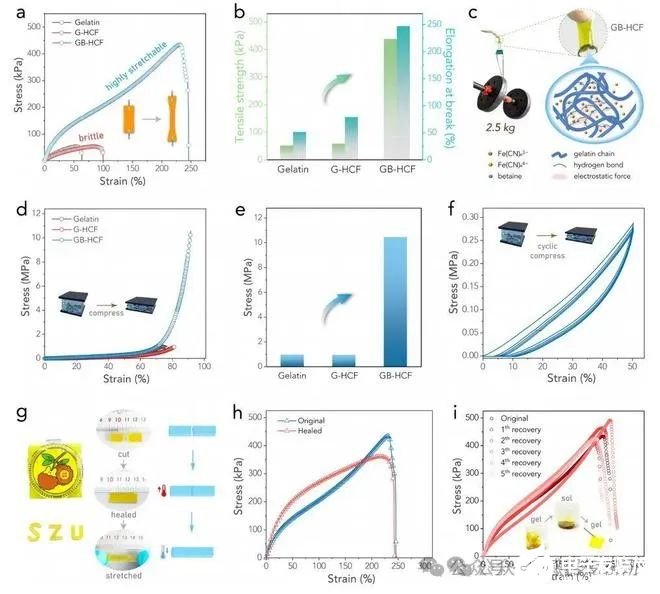
Figure 2. (a) Stress-strain curves of various samples. (b) The corresponding tensile strength and elongation at break of various samples obtained from (a). (c) Demonstration of the GB[1]HCF hydrogel lifting a weight of 2.5 kg. The schematic diagram highlights the role of betaine in the hydrogel network, where the betaine molecules can bind the gelatin chains tightly through multiple non-covalent interactions including hydrogen bonds and electrostatic interactions. (d) Compression curves of various samples. (e) The corresponding compressive strength of various samples obtained from (d). (f) Stress-strain curves of cyclic compression of the GB-HCF. (g) Demonstration of the tailorable GB-HCF hydrogels and their healing capability. (h) Stress[1]strain curves of the GB-HCF before and after healing. (i) Stress-strain curves of the GB-HCF subjected to five recovery cycles. Insets show its self-recovery process based on the sol-gel transformation.
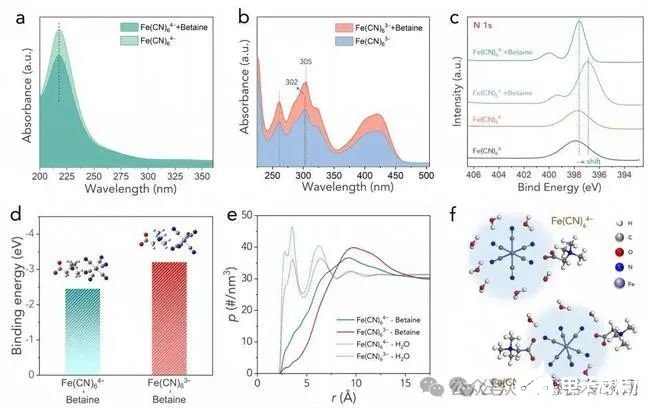
Figure 3. (a) UV-vis spectra of the [Fe(CN)6]4− and [Fe(CN)6]4− + betaine sample. (b) UV-vis spectra of the [Fe(CN)6]3− and [Fe(CN)6]3− + betaine sample. (c) XPS N 1s spectra of various samples. (d) The calculated binding energies for [Fe(CN)6]4-betaine and [Fe(CN)6]3−-betaine. Insets show the optimized binding structures. (e) The radial density profiles between [Fe(CN)6]3−/[Fe(CN)6]4− and water/betaine molecules. (f) The illustration of the solvation structures of [Fe(CN)6]3− and [Fe(CN)6]4− with the presence of betaine.
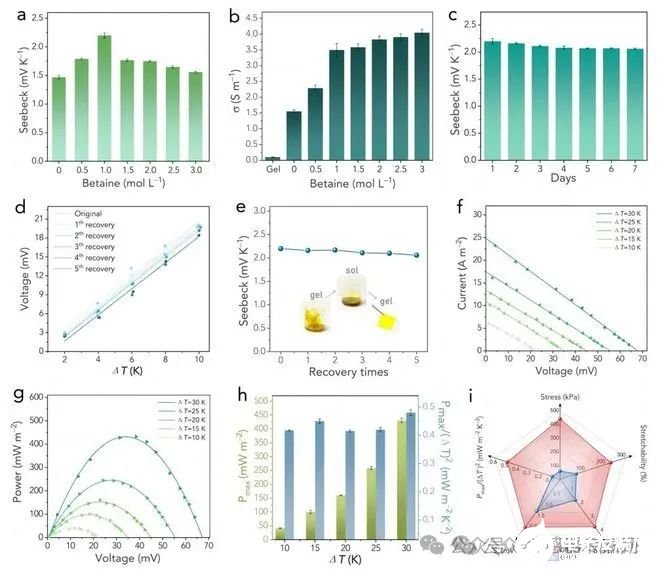
Figure 4. (a) The effect of betaine concentration on the Se. (b) The effect of betaine concentration on the ionic conductivity. (c) The Se change during the rest in air for 7 days. (d)The fitted plots of voltage-temperature difference for different recovery cycles. (e) The measured Se values after different recovery cycles. Insets show the recovery cycle. (f) Current density-voltage plots under different ∆Ts. (g) Power density-voltage plots under different ∆Ts. (h) The calculated maximum specific output power density. (i) Comprehensive comparisons between the GB-HCF based TECs and conventional gelatin-based TECs in terms of Pmax/∆T2, Se, σ, tensile strength, and stretchability.
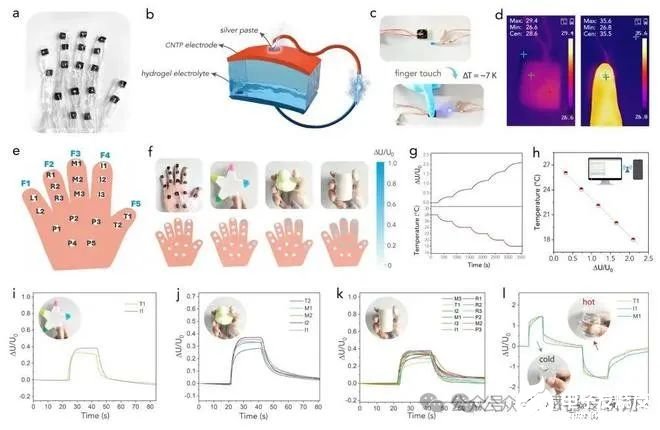
Figure 5. (a) An optical image of the smart glove consisting of 18 TEC blocks. (b) Schematic of the configuration of a single TEC block. (c) Photos showing a TEC block powering a light[1]emitting diode bulb by utilizing the body heat with the assistance of a voltage amplifier. (d) Corresponding infrared thermal images. (e) A schematic of the hand-shaped smart glove. (f)Demonstration of wearing the smart glove device to hold different objects. The schematics in the lower part show the voltage responses in different zones of the hand. (g) The variation of ∆U/U0 values with the variation of the target temperature. (h) The relationship between the ∆U/U0 values and the target temperature. (i-l) The voltage responses of the device when the hand was touching a pentagram toy, a duck toy, a cylinder, and a cold/hot water cup. Insets are the photos showing how the hand was holding the objects.
声明:转载此文是出于传递更多信息之目的,若有来源标注措误或侵犯了您的合法权益,请与我们联系,我们将及时更正、删除,谢谢。
-
具有密集交联结构的明胶基水凝胶电解质(ODGelMA)2024-05-22 2074
-
不同类型的电池的电解质都是什么?2024-02-27 3541
-
深圳大学实现红外隐身兼容电磁屏蔽的柔性可穿戴复合纺织品2023-12-22 3778
-
基于MXene水凝胶实现可穿戴人机交互,用于智能水下通信和传感救援2023-08-21 2207
-
如何利用液滴微流控技术制造聚两性电解质纳米微凝胶?2023-07-17 2068
-
天津科技大学:研发细菌纤维素水凝胶及其应用柔性传感器2023-03-02 1603
-
湖南工业大学:研发低力学损耗、快速响应的导电水凝胶传感器2023-02-11 1795
-
钠离子电池的电解质分类2022-10-09 6311
-
电解质型倾角传感器在天线控制中的应用2018-11-14 1773
-
超薄电解质电容器问世 手机可迎袖珍化时代2014-09-24 3232
-
我想自己测试电解质2013-03-09 2711
-
电池内的电解质是什么?2009-10-20 1162
-
CA型固体电解质钽电容器2009-08-21 1399
全部0条评论

快来发表一下你的评论吧 !

